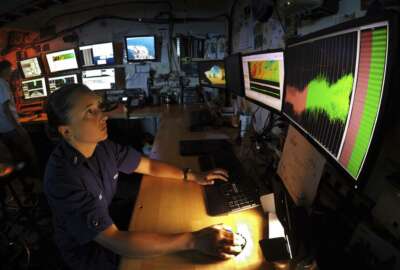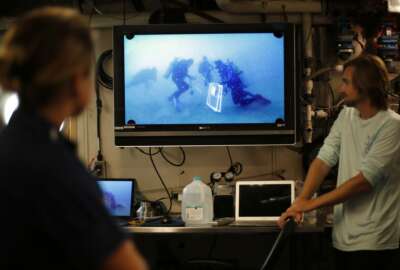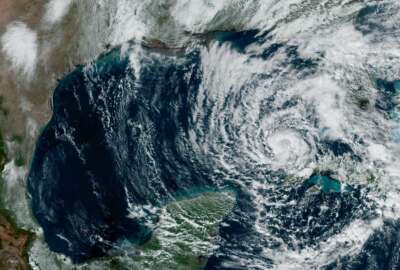
NOAA’s data sharing with windmill developer could yield ocean insight for both parties
For the whys and wherefores of the agreement, Federal Drive with Tom Temin turned to NOAA's integrated ocean and coastal mapping coordinator, Ashley Chappell.
Best listening experience is on Chrome, Firefox or Safari. Subscribe to Federal Drive’s daily audio interviews on Apple Podcasts or PodcastOne.
The National Oceanic and Atmospheric Administration signed a first-ever data sharing agreement with a private company – a developer of offshore windmill farms. Both parties have an interest in learning more about what’s going on in coastal waters. For the whys and wherefores of the agreement, Federal Drive with Tom Temin turned to NOAA’s integrated ocean and coastal mapping coordinator, Ashley Chappell.
Interview transcript:
Tom Temin: Ms. Chappell, good to have you on.
Ashley Chappell: Thank you.
Tom Temin: Alright, tell us about this agreement. What are you trying to achieve here and tell us who this company is?
Ashley Chappell: Well, this is our first ever agreement with an offshore wind energy company, Ørsted, which is the North American arm of a Danish wind energy company. And the agreement encompasses a broad range of data types to share with Ørsted and from Ørsted to NOAA, from meteorological observations to biological data to bathymetric data about ocean depth.
Tom Temin: Got it. So backing up a step then, when someone builds an offshore windmill, I guess, or a series of them, they’re anchored in the ocean in some manner so they have the opportunity to have sensors and data collection mechanisms about what’s going on in the waters in which these windmills sit. Is that the general picture of how it works?
Ashley Chappell: Yes, exactly. Actually, these companies have to do a lot of research and data collection, even before they head out to the water, they need to get information in on what is out there before they can even start construction. So it’s quite an extensive effort, as you can imagine.
Tom Temin: Sure. What are the types of data that they look at that are also useful to NOAA?
Ashley Chappell: Well, they’re looking at meteorological conditions, they’re looking at the seabed surface. Can they construct something there? What are the habitats in and around where they might want to place wind energy infrastructure? They’re collecting the bathymetry, which is ocean depth, like I said. And the other parameters around the water and the habitats, the environments that are there, they are collecting biological data, perhaps about the inhabitants of that area so as not to damage marine life and established communities. That sort of thing. And all of that data is useful to NOAA’s ocean science research and operations.
Tom Temin: And do these companies look at all of this data for a period of time before construction? And then do they also continue to monitor those parameters after the project is done and the wind farm is operating?
Ashley Chappell: Yes.
Tom Temin: And in the case of Ørsted here, do we know how far offshore they are going to be looking at this data? Is it in deep water? Is it in fairly shallow water beyond where the beach might end? Or where is it?
Ashley Chappell: The lease areas that are managed by the Bureau of Ocean Energy Management, BOEM, are in the outer continental shelf. So that location varies. They might be 20 miles or more 20 nautical miles or more offshore.
Tom Temin: Okay, so wind farms can be located that far offshore and still get power into the into the land?
Ashley Chappell: Yes, they’ll be running cables from the turbines to land.
Tom Temin: Okay. And does NOAA itself have data gathering activities in those types of far continental shelf waters? I know you’ve got buoys all over the place and ships and submarines and satellites. But is that a band of the ocean that NOAA itself does data gathering in?
Ashley Chappell: NOAA gathers data all over our exclusive economic zone waters. But resources are finite, and no one entity can gather data everywhere that we would all like to gather data. So this sharing is actually really very appreciated and valuable to NOAA for information in places where we don’t have data perhaps or new data in areas that we we have data where we can now do change analysis or understand what’s happening in our oceans.
Tom Temin: And the sharing agreement you have, how does it work? They will ship you thumb drives from what they gather off shore — how does it all work technically?
Ashley Chappell: These data sets are of varying sizes, some are enormous, as you could imagine. Bathymetric data, for example, is huge. And then some are smaller, meteorological data I think is pretty petite compared to the bathymetry. And so it will happen in a variety of ways, by email by FTP transfer, perhaps even by hard drive transfers. Those details will be worked out and in each case, Ørsted will say this is the data that we have available to share for meteorological observations, for example, and we will figure out at that point the best route to receive it.
Tom Temin: And you’ll be sending them data also. So it sounds like there is some area of data that you may gather that they don’t have, and vice versa.
Ashley Chappell: Well, yes. But of course, all of the data that NOAA acquires is available to the public. So we will be working with Ørsted to make sure that they know where that data is, and finding it. But that data is available to them, yes.
Tom Temin: And when does this all start? Are you underway yet?
Ashley Chappell: We’re underway in discussions on some of our first data sets, and we hope to see data actually changing hands by the end of the summer.
Tom Temin: And how will this enhance NOAA’s own activities?
Ashley Chappell: These types of data factor into our science and research and the models we use for many different things from atmospheric predictions to storm surge models to nautical charts. All of this data has value to NOAA and will be used for different things. I mean, these observations, predictions and information will supplement our own observing systems and data acquisition that we use in our science.
Tom Temin: Ashley Chappell is integrated ocean and coastal mapping coordinator at the National Oceanic and Atmospheric Administration. Thanks so much for joining me.
Ashley Chappell: Thank you.
Copyright © 2025 Federal News Network. All rights reserved. This website is not intended for users located within the European Economic Area.
Tom Temin is host of the Federal Drive and has been providing insight on federal technology and management issues for more than 30 years.
Follow @tteminWFED
Related Stories





